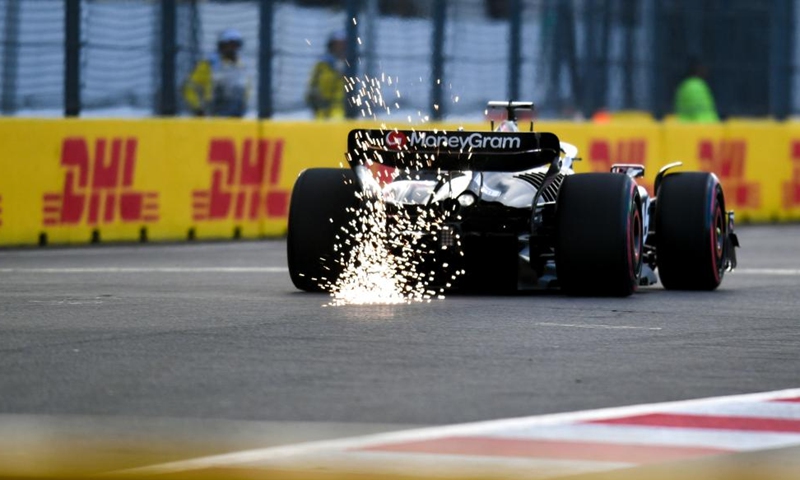ARTS / CULTURE & LEISURE
Formula E returns to China; sparse attendance highlights uphill climb

Haas F1 Team's Kevin Magnussen of Denmark competes during a practice session of the 2023 Formula One Mexico City Grand Prix at the Hermanos Rodriguez Circuit in Mexico City, Mexico, Oct. 27, 2023. (Photo: Xinhua)
This past weekend, the Shanghai International Circuit hosted the Formula E (FE) Shanghai E-Prix, marking its return to China after a five-year hiatus. However, the sparse attendance in the grandstands was a stark contrast to the packed venue seen during the Formula 1 (F1) Chinese Grand Prix held in April.
Despite the excitement surrounding the 10th anniversary of this event, which originated in Beijing, the race this year failed to capture the same fervor, though China in recent years has emerged as the leading market for electric vehicles.
FE's inception was timely, aligning with a global shift toward automotive electrification. The first-ever race was held in Beijing, around the iconic Birds' Nest and Water Cube, setting the stage for what was envisioned as a groundbreaking series.
Initially, FE garnered significant interest from major automotive brands like Renault, Audi, Jaguar, Nissan, BMW, Mercedes and Porsche. At its peak, 10 out of the 12 competing teams were manufacturer-backed, a level of involvement that even F1 has rarely seen.
However, this success was short-lived. Fans attendance dwindled, and several key manufacturers exited the series. Even during the challenging 2020-21 season, FE maintained a robust lineup of 10 manufacturer teams. But by the 2023-24 season, only Jaguar, Nissan, Porsche, and DS remained, with notable absences from the German manufacturers BMW, Mercedes and Audi as well as Chinese brand NIO.
Several key factors contributed to this decline. Compared to F1, FE imposes stringent restrictions on car performance, including those for battery capacity, acceleration and top speed. Teams can only make limited modifications to energy management systems and race strategies.
These constraints might hinder the ability of manufacturers to test new electric technologies on the track, diminishing the series' appeal as a developmental platform for manufacturers.
FE has introduced several rules to enhance spectator engagement, such as fan-boosted power for drivers, temporary power boosts for attacks and energy recovery systems during races. While these rules add a layer of excitement, they also undermine the competitive integrity of the series. For manufacturers investing substantial resources, these entertainment-driven rules have somehow detracted from the serious business of manufacturers' technical advancement.
The rapid pace of automotive electrification has slowed down in some countries in recent years, as some manufacturers have adjusted their strategies to focus less on full electric vehicles. This shift directly impacts their commitment to FE, reducing support and funding for possible participation in the series.
Despite being under the same FIA umbrella, F1 and FE are in direct competition. F1 has long been the pinnacle of motorsports, but its traditional reliance on internal combustion engines was seen as increasingly out of step with modern environmental concerns.
In response, F1 will adopt a 50:50 hybrid system from 2026, with plans to use biofuels in the future. In April, F1 revealed a 13 percent reduction in carbon emissions from 2018 to 2022 and said that they are on track to reach carbon net zero by 2030. This shift not only aligns F1 with contemporary sustainability goals but also repositions it as a prime testing ground for hybrid technologies, attracting renewed interest from car manufacturers. This resurgence of F1 is also a significant challenge to FE's relevance.
To regain its former glory and attract more attention, it might be better for FE to consider relaxing its restrictive regulations, giving teams and manufacturers greater freedom to innovate. Similar to F1, where engine power and aerodynamics are key competitive elements despite regulatory limits, FE could benefit from a more open approach to technology development.
Currently, FE races often end with minimal time differences between the first and last cars. This lack of variability and continuous overtaking excitement means fans easily grow tired of the race. Emphasizing car speed and driver skill over energy conservation could restore the thrilling, high-stakes nature of racing that fans crave.
FE faces significant challenges in China, from restrictive technical regulations to competition from a revitalized F1. By focusing on competitive purity and technical innovation, FE can potentially attract more manufacturers and spectators, securing its future as a premier motorsports series
The author is a reporter with the Global Times. life@globaltimes.com.cn


